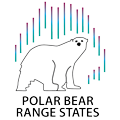Ensure the conservation of essential habitat for polar bears
This webpage is under construction
- Objective Leads
- Actions associated with Objective 3 in the 2020-2023 Implementation Plan
- Implementation approach
- Polar Bear threats linked to the Objective and how the Objective’s Actions will address them:
- Expected impact/ outcome of the Objective-3 workplan:
- How the progress toward Objective-3 will be evaluated
- Liaison with external bodies
- Expected dissemination of Deliverables and Outcome to stakeholders
- Potential Challenges and how they will be addressed (mitigation actions)[1]
Objective Leads
Lauren Schmuck (Environment and Climate Change Canada,
Sofie Abelsen (Greenland Ministry of Fisheries, Hunting and Agriculture,
Actions associated with Objective 3 in the 2020-2023 Implementation Plan
(see top-left sidebar for further information on the action)
EH – A2: Define levels of protective status of polar bear essential (or commonly used) habitat (i.e., winter, summer and denning habitat).
Implementation approach
It is anticipated that Polar Bear Specialist Group (PBSG) will work with the Polar Bear Range States to complete the work associated with Objective 3.
Polar Bear threats linked to the Objective and how the Objective’s Actions will address them:
Climate change and extent and composition of sea ice: The Circumpolar Action Plan (CAP) identifies climate change and the associated reductions in the extent and composition of sea ice to be the greatest threat to polar bear persistence. Polar bears rely on sea ice habitat as a platform to hunt seals and it is likely that climate change will result in a reduction to the quantity, quality, and availability of sea ice in the coming years. Further, as denning habitat is necessary for polar bear reproduction, the identification and protection of maternity denning habitat is crucial. Therefore, a reduction in the quantity and quality of essential (or commonly used) winter, summer, and denning habitat as a result of climate change is a threat to polar bears.
Therefore, work to determine the levels of protective status of essential (or commonly used) winter, summer, and denning polar bear habitat will provide an important contribution toward achieving the vision of the Circumpolar Action Plan.
Levels of the Threats:
Climate change and extent and composition of sea ice: High
Expected impact/ outcome of the Objective-3 workplan:
Expected outcome of EH-A2: In order to determine which areas of essential (or commonly used) habitat need to be protected, it is important to first determine which areas currently are, and are not, protected. The anticipated outcome of the Objective 3 work for the 2023-25 period is a better understanding of:
- Which areas of essential (or commonly used) habitat are currently protected,
- Which areas are not currently protected,
- What level(s) or mechanism(s) of protection (e.g., regional, national, international, Indigenous, other) are in place in those areas that are protected?
How the progress toward Objective-3 will be evaluated
The proportion of those areas of habitat that were identified as essential (or commonly used) which have been identified as either protected (and if so, at which level or by which mechanism), or not protected, will determine the progress towards achieving the goals of Objective 3 for the CAP 2023-25 period.
Performance Metrics
TBD
|
Performance metrics |
Baseline in 2020 |
Status by May 2023 |
Expected status by 2025 |
|
Indicator-1: |
|||
|
Indicator-2: |
|
|
|
|
Indicator-3: |
|
|
|
Liaison with other CAP-Objectives
There was some liaison with CAP Objective 2 (Climate Change Communications) during CAP 2020-23, however, no liaison with other Objectives is anticipated for the CAP 2023-25 period.
Liaison with external bodies
(i.e. organizations, communities, stakeholders, expert groups, etc.)
The workplan for CAP Objective-3 is implemented in cooperation with specialists of the IUCN/Polar Bear Specialist Group.
Expected dissemination of Deliverables and Outcome to stakeholders
(public, policy makers, legislators etc.)
The maps produced as the product of Action EH-A1 during CAP 2020-23 were shared with the Range States. Once EH-A2 is complete, maps illustrating where protected areas occur in relation to essential (or commonly used) polar bear habitats will be produced. The channels and format of the dissemination of these maps is to be defined.
Potential Challenges and how they will be addressed (mitigation actions)[1]
- It is possible that there will be some barriers to individual Range States providing the GIS “layers” necessary to map the boundaries of protected areas that occur within their respective countries. This could present a challenge if we want the maps of protected areas and essential/commonly used habitats to be inclusive of all 19 polar bear subpopulations.
Mitigation measure(s): Work with the Range States to understand their limitations, and what alternatives can be provided. - In order to produce the maps of protected areas in relation to essential/commonly used polar bear habitats, it will likely be necessary to obtain the raw GIS data that was used to create the maps of essential/commonly used polar bear habitat during Action EH-A1. Given the challenges associated with data permissions, ownership, etc., it could prove difficult to obtain the required raw GIS data.
Mitigation measure(s): Drafting a data-sharing agreement that limits the use of the GIS data to this specific project, and/or discussing the steps required for map production, and each country could produce their own map and retain the data for it.
[1] The level of challenge is estimated by multiplying the level of likelihood (scale 1-5) by the negative impact it may have (scale 1-5). Minor: 1-10, Moderate: 11-15; Severe: 16-25.
